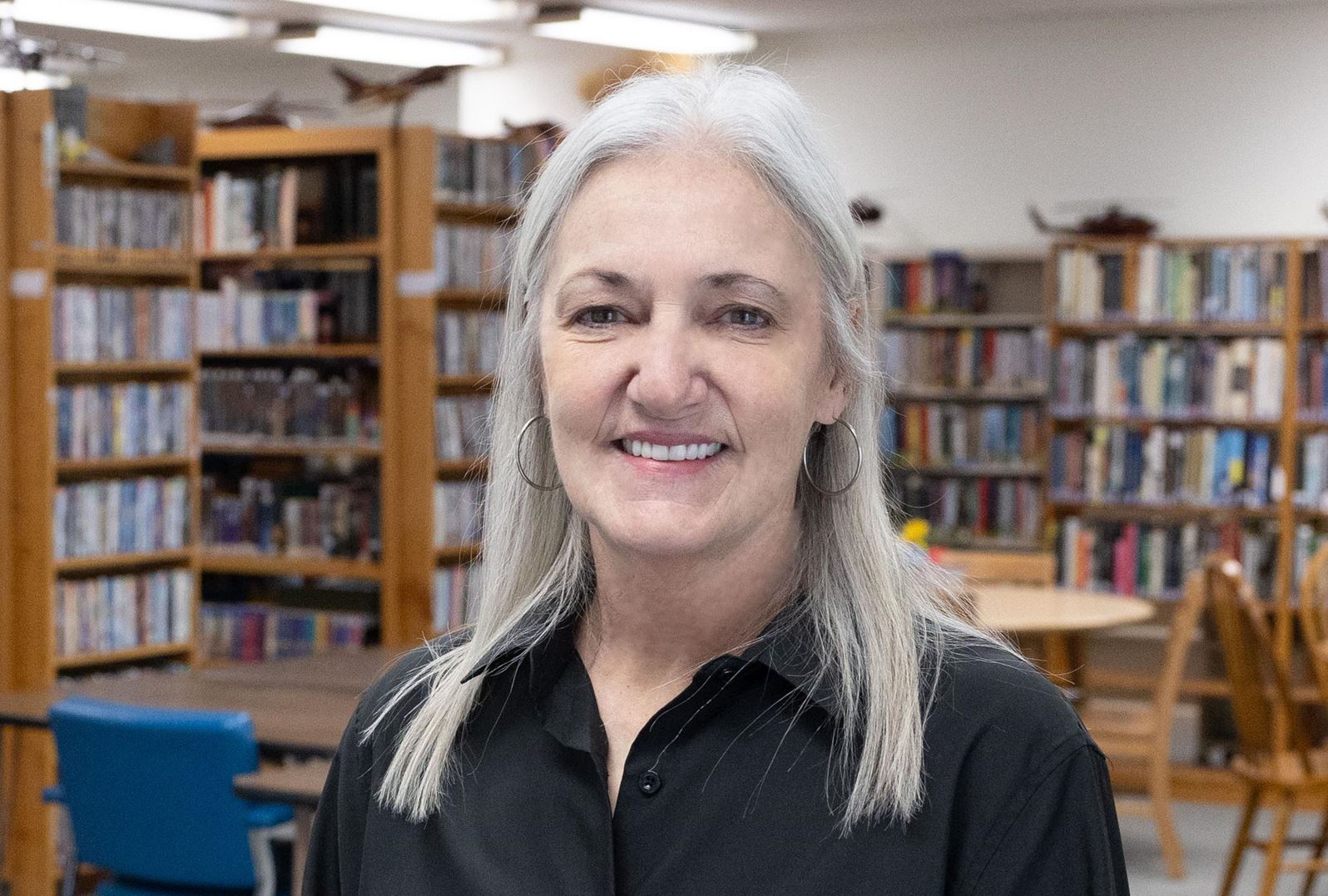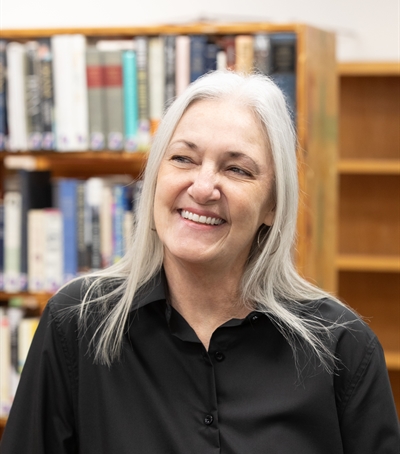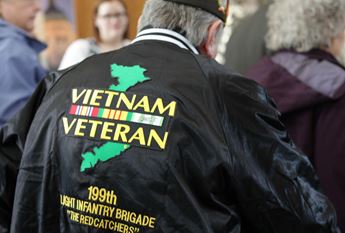

Meet Jacque Sherrill
What’s your Kansas story?
My mother was born and raised in Englewood, KS. My dad was from Missouri, and I was born there, but my parents moved to Kansas when I was two, so this has always been home to me. I dislike crowds and traffic, so the slower pace in southwest Kansas is a great fit for me. I never wanted to live anywhere else but a small Kansas town.
Describe what you do now. What inspires you about what you do?
More Stories
Frank Wickware: From Girard, Kansas to Schenectady, New York African American Soldiers in the Civil War: A Kansas Story Celebrating Our Stories: Topeka Trailblazers For the Love of the PrairieI have been the library director at Jetmore Public Library for more than 30 years. I enjoy writing and photography, and I studied art in college, so these interests have been beneficial, and useful, in my library career, as well. I was read to as a child, and my family encouraged reading. There were always books and magazines in our house. I still have books in my personal collection that I received as a child, so that fondness for books has always been part of my life.
I think it is important to arrange opportunities for informational and learning programs at the library. For the past two years, we have held Community Conversations, every other month, that are varied in topic, and always well-attended. We also have adult programs throughout the year, with diverse guest speakers, and they are consistently popular.
When you hear the word “humanities,” what comes to mind?
For me, "humanities" means the variety and importance of human culture, and the sharing of human spirit and knowledge.
Share a memory or experience when the humanities—whether art, literature, music, or a film—deeply resonated with you or left a lasting impression?
Kansas stories are historically significant and consist of many narratives. The experiences of various communities including Mexican Americans, African Americans, and Native Americans, greatly contribute to the evolving cultural history of our state.
In 2019, I was invited by Humanities Kansas to be part of a panel speaking before the National Endowment for the Humanities in Wichita. During that trip, the group visited The Kansas African American Museum, formerly the Calvary Baptist Church, built in 1917. There were various exhibits, but one, titled "The Color Line," included beautiful, larger than life, candid portraits of local residents who grew up through the making ---and re-making --- of Wichita’s North End and Northeast neighborhoods. I returned home inspired, and wanted to create a similar exhibit, featuring descendants of Dodge City’s Mexican Village. What started in the early 1900s, as a small cluster of shelters for laborers in the rail yard, grew into a village complete with a grocery store, a dance hall, a church and a school. The Mexican Villagers made homes from old railroad ties and rail-car sidings, and the village grew into a self-sufficient, close-knit community of 373 residents by 1931. After Dodge City razed the Mexican Village in 1955, most families moved north of the railroad tracks to a neighborhood that came to be known as the “East Side.”
I received a HK grant to create a portrait exhibit that would explore changes in the faces of the descendants of the “East Side” neighborhoods over 6 + decades. The project debuted at the Carnegie Center for the Arts during Hispanic Heritage Month. Former Kansas Poet Laureate, Huascar Medina, invited to do a poetry reading influenced by the portraits of the “Faces of the East Side,” created original poems for each portrait that became part of the display. The portraits were featured at the Santa Fe Depot Theater by the Dodge City Convention & Visitors Bureau and a traveling exhibit of the scaled down portraits and poems was created and shared at libraries across the state. One of the portraits from the project became part of Boot Hill Museum’s permanent Mexican Village exhibit. This Humanities Kansas project paid tribute to the Villagers, and generations of their descendants, who remain an important part of Dodge City’s heritage. My inspiration lead to a shared, memorable experience that left a lasting impression.
Why do stories matter in Kansas today?
In 2018, the Jetmore Public Library was one of twelve organizations selected by HK to participate in “Kansas Stories of the Vietnam War.” I attended training and received certification for this project. The next year, one hundred transcribed interviews, documents, photos and video recordings, were presented to the Library of Congress to become part of the Veterans Voice Project Archives in Washington, D.C. My interviews included the wife of Vietnam veteran, and mother of five, who kept the home fires burning while her Army husband completed several tours of duty in Vietnam; a retired educator, and former Kansas Legislator, who happened to also be a Vietnam War protester - two of her students had been killed in Vietnam; and a Laotian refugee who had escaped Vietnam with her three young children, immigrated to the U.S., and for several years operated a restaurant in downtown Jetmore. I incorporated a series of public events into our project including Kansas Honor Flights that led to two of our local Vietnam veterans being honored with an all-expenses paid trip to Washington, D.C. to visit the War Memorials and A Quilt of Valor ceremony, with a group of home town quilters, who created a patriotic quilt and gifted it to a decorated U.S. Army veteran of both Korea and Vietnam, was held at a reception in his honor. A Humanities- sponsored workshop, with Kansas author, Al Ortolani, helped others begin writing their own personal memoirs to help preserve the memories of what it was like to serve, or to have a friend, or family member serve. The library also erected, and dedicated, a Military Wall of Honor located in its foyer. To date, over 150 framed photographs of veterans, with ties to Hodgeman County, have been added to the display and the library’s website.

What about your community inspires you? What about Kansas inspires you?
In my opinion, rural communities are the mainstay of society, and I am incredibly fortunate to have grown up in, and raised my own family in, such a strong community. We may be small in population, but there are no shortage of ideas and opportunities for progress.
What do you wish people knew or understood about Kansas?
Kansas has beautiful terrains, and it is not all pastures and flatlands, even though I personally love those expansive views.
What is a cultural attraction in Kansas that everyone should experience that is uniquely Kansas?
One of my favorite places is Pawnee Rock State Historic Site in Barton County, a landmark on the Santa Fe Trail. The roof top is about 50 or 60 feet high and provides a bird’s eye-view of the surrounding plains.
What is a Kansas culinary dish or restaurant everyone should try?
I grew up eating Sandhill Plum jelly that my mother harvested and canned every summer. There are store-bought versions available, but none ever came close to hers. She ran a local restaurant for many years and became known for her cinnamon rolls. People still talk about them and ask for the recipe, but she never used one. She also made the best chicken-fried steak.



